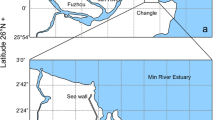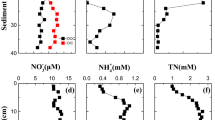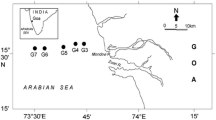Abstract
Benthic sulfate reduction and sediment pools of sulfur and iron were examined during January 1992 at 3 stations in the Ao Nam Bor mangrove, Phuket, Thailand. Patterns of sulfate reduction rates (0–53 cm) reflected differences in physical and biological conditions at the 3 stations, and highest rates were found at the vegetated site within the mangrove (Rhizophora apiculata) forest. Due to extended oxidation of mangrove sediments, a large portion of the added35S-label was recovered in the chromium reducible pools (FeS2 and S0) (41–91% of the reduced sulfur). Pyrite was the most important inorganic sulfur component, attaining pool sizes 50–100 times higher than acid volatile pools (FeS). HCl-extractable (0.5 M HCl) iron pools, including Fe(II)HCl and Fe(III)HCl, were generally low and Fe(III)HCl was only present in the upper surface layers (0–5 cm). Maximum concentrations of dissolved Fe2+ (35–285 μM) occurred just about the depth where dissolved ΣH2S accumulated. Furthermore Fe2+ and ΣH2S coexisted only where concentrations of both were low. There was an accumulation of organic sulfur in the deep sediment at 2 stations in the inner part of the mangrove. The reoxidation of reduced sulfides was rapid, and storage of sulfur was minor in the upper sediment layers, where factors like bioturbation, the presence of roots, or tidal mixing enhance oxidation processes.
Similar content being viewed by others
References
Alongi DM (1989) The role of soft-bottom benthic communities in tropical mangrove and coral reef ecosystems. Rev. Aquat. Sci. 1: 243–280
Altschuler ZS, Schnepfe MM, Silber CC & Simon FO (1983) Sulfur diagenesis in everglades peat and origin of pyrite in coal. Science 221(4607): 221–227
Andersen FØ & Kristensen E (1988) Oxygen microgradients in the rhizosphere of the mangroveAvicennia marina. Mar. Ecol. Prog. Ser. 44: 201–204
Canfield DE (1989) Reactive iron in marine sediments. Geochim. Cosmochim. Acta 53: 619–632
Canfield DE, Raiswell R & Bottrell S (1992) The reactivity of sedimentary iron minerals toward sulfide. Am. J. Sci. 292: 659–683
Carlson PR, Yarbro LA, Zimmermann CF & Montgomery JR (1983) Pore water chemistry of an overwash mangrove island. Florida Sci. 46(3/4): 233–238
Casagrande DJ, Siefert K, Berschinski C & Sutton N (1977) Sulfur in peat-forming systems of the Okefenokee Swamp and Florida Everglades: origins of sulfur in coal. Geochim. Cosmochim. Acta 41: 161–167
Cline JD (1969) Spectrophotometric determination of hydrogen-sulfide in natural waters. Limnol. Oceanogr. 14: 454–458
Ferdelman TG, Church TM & Luther III GW (1991) Sulfur enrichment of humic substances in a Delaware salt marsh sediment core. Geochim. Cosmochim. Acta 55: 979–988
Fossing H & Jørgensen BB (1989) Measurement of bacterial sulfate reduction in sediments: evaluation of a single-step chromium reduction method. Biogeochem. 8: 205–222
Fossing H, Thamdrup B & Jørgensen BB (1992) Havbundens svovl-, jern- og mangankredsløb i . Danish Environmental Protection Agency. Publication No. 15. Copenhagen
Francois R (1987) The influence of humic substances on the geochemistry of iodine in nearshore and hemipelagic marine sediments. Geochim. Cosmochim. Acta 51: 2417–2427
Gardner LR (1990) Similation of the diagenesis of carbon, sulfur, and dissolved oxygen in salt marsh sediments. Ecological Monographs 60: 91–111
Giblin A (1988) Pyrite formation in marshes during early diagenesis. Geomicrobiol. J. 6: 77–97
Giblin AE & Howarth RW (1984) Porewater evidence for a dynamic sedimentary iron cycle in salt marshes. Limnol. Oceanogr. 29(1): 47–63
Hart MGR (1959) Sulphur oxidation in tidal mangrove soils of Sierra Leone. Plant and Soil 11(3): 215–236
Higashi T & Shinagawa A (1985) Soils of a mangrove forest composed ofRhizophora mucronata andBruguiera gymnorrhiza from Ishigaki Island, Japan. Soil Sci. Plant Nutr. 31(3): 427–435
Hines ME, Knolmeyer SL & Tugel JB (1989) Sulfate reduction and other sedimentary biogeochemistry in a northern New England salt marsh. Limnol. Oceanogr. 34(3): 578–590
Hines ME, Bazylinski DA, Tugel JB & Lyons WB (1991) Anaerobic microbial biogeochemistry in sediments from two basins in the Gulf of Maine: evidence for iron and manganese reduction. Estuar. Coast. Shelf. Sci. 32: 313–324
Howarth RW (1984) The ecological significance of sulfur in the energy dynamics of salt marsh and coastal marine sediments. Biogeochem. 1: 5–27
Howarth RW & Giblin A (1983) Sulfate reduction in the salt marshes at Sapelo Island, Georgia. Limnol. Oceanogr. 28(1): 70–82
Howarth RW, Giblin A, Gale J, Peterson BJ & Luther III GW (1983) Reduced sulfur compounds in the pore waters of a New England salt marsh. Environ. Biogeochem. Ecol. Bull. 35: 135–152
Howarth RW & Jørgensen BB (1984) Formation of35S-labelled elemental sulfur and pyrite in coastal marine sediments (Limfjorden and Kysing Fjord, Denmark) during short-term35SO4 2− reduction measurements. Geochim. Cosmochim. Acta 48: 1807–1818
Howarth RW & Merkel S (1984) Pyrite formation and the measurement of sulfate reduction in salt marsh sediments. Limnol. Oceanogr. 29(3): 598–608
Huettel M & Gust G (1992) Impact of bioroughness on interfacial solute exchange in permeable sediments. Mar. Ecol. Prog. Ser. 89: 253–267
Jørgensen BB (1978) A comparison of methods for the quantification of bacterial sulfate reduction in coastal marine sediments. I. Measurements with radiotracer techniques. Geomicrobiol. J. 1: 11–27
Jørgensen BB (1982) Mineralization of organic matter in the sea bed — the role of sulfate reduction. Nature 296: 643–645
Jørgensen BB, Bang M & Blackburn TH (1990) Anaerobic mineralization in marine sediments from the Baltic Sea-North Sea transition. Mar. Ecol. Prog. Ser. 59: 39–54
King GM (1988) Patterns of sulfate reduction and the sulfur cycle in a South Carolina salt marsh. Limnol. Oceanogr. 33(3): 376–390
Kohnen MEL, Sinninghe Damsté JS, Kock-Van Dalen AC, Ten Haven HL, Rullkötter J & De Leeuw JW (1990) Origin and diagenetic transformations of C25 and C30 highly branched isoprenoid sulphur compounds: further evidence for the formation of organically bound sulphur during early diagenesis. Goechim. Cosmochim. Acta 54: 3053–3063
Kristensen E & Andersen FØ (1987) Determination of organic carbon in marine sediments: a comparison of two CHN-analyzer methods. J. Exp. Mar. Biol. Ecol. 109: 15–23
Kristensen E, Holmer M, Bussarawit N (1991) Benthic metabolism and sulfate reduction in a southeast Asian mangrove swamp. Mar. Ecol. Prog. Ser 73: 93–103
Kristensen E, Devol AH, Ahmed SI & Saleem M (1992) Preliminary study of benthic metabolism and sulfate reduction in a mangrove swamp of the Indus Delta, Pakistan. Mar. Ecol. Prog. Ser. 90: 287–297
Kristensen E, King GM, Holmer M, Banta GT, Jensen MH & Hansen K (1994) Sulfate reduction, acetate turnover and carbon metabolism in sediments of the Ao Nam Bor Mangrove, Phuket, Thailand. Mar. Ecol. Prog. Ser. 109(2–3): 245–255
Lord III CJ & Church TM (1983) The geochemistry of salt marshes: sedimentary ion diffusion, sulfate reduction, and pyritisation. Geochim Cosmochim. Acta 47: 1381–1391
Lovley DR & Phillips EJP (1987) Rapid assay for microbially reducible ferric iron in aquatic sediments. Appl. Environ. Microbiol. 53: 2636–2641
Luther III GW, Giblin AE & Varsolona RV (1985) Polarographic analysis of sulfur species in marine porewaters. Limnol. Oceanogr. 30(4): 727–736
Luther III GW, Church TM, Scudlark JR & Cosman M (1986) Inorganic and organic sulfur cycling in salt-marsh pore waters. Science 232: 746–749
Luther III GW, Ferdelman TG, Kostka JE, Tsamakis EJ & Church TM (1991) Temporal and spatial variability of reduced sulfur species (FeS2, S2O3 2−) and porewater parameters in salt marxh sediments. Biogeochem. 14: 57–88
McKee KL, Mendelssohn IA & Hester MW (1988) Reexamination of pore water sulfide concentrations and redox potentials near the aerial roots ofRhizophora mangle andAvicennia germinans. Amer. J. Bot. 75(9): 1352–1359
Mongia AD & Ganeshamurthy AN (1989) Typical differences between the chemical characteristics ofRhizophora andAvicennia mangrove forest soils in South Andamans. Agrochimica. 33(6): 464–470
Moses CO & Herman JS (1991) Pyrite oxidation at circumneutral pH. Geochim. Cosmochim. Acta 55: 471–482
Oenema O (1990) Pyrite accumulation in salt marshes in the Eastern Scheldt, southwest Netherlands. Biogeochem. 9: 75–98
Rickard DT (1975) Kinetics and mechanism of pyrite formation at low temperatures. Am. J. Sci. 275: 636–652
Silva CAR, Lacerda LD & Rezende CE (1990) Metals reservoir in a red mangrove forest. Biotropica 22(4): 339–345
Skyring GW (1987) Sulfate reduction in coastal ecosystems. Geomicrobial. J. 5 (3/4): 295–374
Stookey LL (1970) Ferrozine — a new spectrophotometric reagent for iron. Analyt. Chem. 42: 779–781
Swider KT & Mackin JE (1989) Transformation of sulfur compounds in marsh-flat sediments. Geochim. Cosmochim. Acta 53: 2311–2323
Sørensen J (1982) Reduction of ferric iron in anaerobic, marine sediment and interaction with reduction of nitrate and sulfate. Appl. Environ. Microbiol. 43: 319–324
Thibodeau FR & Nickerson NH (1986) Differential oxidation of mangrove substrate byAvicennia germinans andRhizophora mangle. Amer. J. Bot. 73(4): 512–516
Thode-Andersen S & Jørgensen BB (1989) Sulfate reduction and the formation of35S-labeled FeS, FeS2, and S° in coastal marine sediments. Limnol. Oceanogr. 34(5): 793–806
Urban NR & Brezonik PL (1993) Transformation of sulfur in sediment microcosms. Can. J. Fish. Aquat. Sci. 50: 1946–1960
Wallmann K, Hennies K, König I, Petersen W & Knauth H-D (1993) New procedure for determining reactive Fe(III) and Fe(II) minerals in sediments. Limnol. Oceanogr. 38(8): 1803–1812
Author information
Authors and Affiliations
Additional information
Author of correspondence.
Rights and permissions
About this article
Cite this article
Holmer, M., Kristensen, E., Banta, G. et al. Biogeochemical cycling of sulfur and iron in sediments of a south-east Asian mangrove, Phuket Island, Thailand. Biogeochemistry 26, 145–161 (1994). https://doi.org/10.1007/BF00002904
Received:
Accepted:
Issue Date:
DOI: https://doi.org/10.1007/BF00002904




